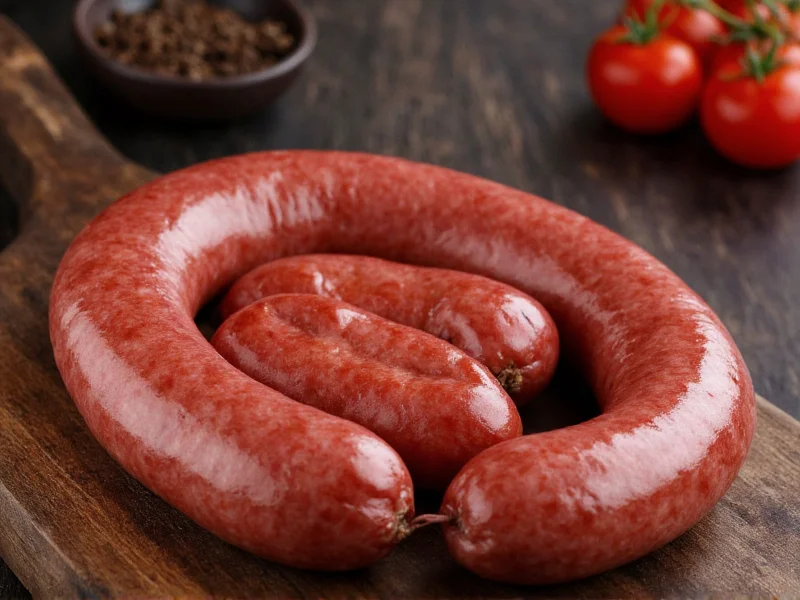When exploring the history of Texas barbecue, few regional specialties carry as much cultural significance as Elgin sausage. This unique smoked meat product represents more than just food—it's a culinary tradition deeply rooted in Central Texas German and Czech immigrant heritage. Unlike mass-produced sausages found nationwide, authentic Elgin sausage maintains specific characteristics that have remained consistent for over a century.
The Historical Roots of Elgin Sausage
Elgin sausage traces its origins to the late 19th century when German and Czech immigrants settled in Central Texas. These communities brought their sausage-making traditions, adapting them to local ingredients and conditions. The town of Elgin, Texas, became particularly renowned for its meat processing, with the Meyer's Elgin Smokehouse establishing itself as the epicenter of this tradition in 1893.
What began as a practical method for preserving meat evolved into a distinctive regional specialty. The original producers developed a specific recipe and smoking technique that created a product with consistent quality and flavor profile. This consistency became the hallmark of genuine Elgin sausage, setting it apart from other smoked meats.
Defining Characteristics of Authentic Elgin Sausage
Several elements distinguish true Elgin sausage from ordinary smoked sausages:
- Coarse grind—Maintains visible meat texture rather than a fine emulsion
- Natural casings—Traditionally uses beef middles instead of synthetic casings
- Specific spice blend—Features black pepper as the dominant flavor with supporting notes of garlic and other seasonings
- Smoking process—Cold-smoked over post oak wood for extended periods
- Meat composition—Traditionally made with a combination of beef and pork
The coarse texture is particularly important, as it allows the natural flavors of the meat and smoke to shine through without being masked by excessive binders or fillers common in commercial sausages.
Traditional Preparation Methods
The authentic preparation of Elgin sausage follows methods largely unchanged since the late 1800s. The process begins with selecting quality cuts of beef and pork, which are coarsely ground to maintain texture. The meat mixture receives a specific spice blend dominated by freshly cracked black pepper, with supporting flavors that vary slightly between producers.
After stuffing into natural casings, the sausages undergo a cold-smoking process using post oak wood, which imparts a distinctive flavor without cooking the meat. This slow smoking process can take 12-24 hours, allowing the smoke to penetrate deeply while preserving the sausage's raw state. The result is a product that requires cooking before consumption but carries an unmistakable smoky aroma.
| Characteristic | Elgin Sausage | Standard Commercial Sausage |
|---|---|---|
| Grind Texture | Coarse, visible meat chunks | Fine emulsion, uniform texture |
| Casings | Natural (beef middles) | Synthetic or collagen |
| Primary Flavor | Black pepper dominant | Balanced seasoning profile |
| Smoking Process | Cold-smoked over post oak | Often liquid smoke or minimal smoking |
| Meat Composition | Beef and pork blend | Often single meat source |
Cultural Significance in Texas Barbecue
Elgin sausage represents an essential component of Central Texas barbecue culture. Unlike the sausage sides served at many barbecue establishments, authentic Elgin sausage stands as a featured item with its own dedicated following. Texas barbecue enthusiasts recognize it as one of the state's original smoked meat traditions, predating many of the more famous barbecue styles.
The annual Elgin Sausage Festival celebrates this heritage, drawing visitors from across Texas and beyond. Local smokehouses maintain waiting lists for their products, particularly during holiday seasons, demonstrating the enduring popularity of this regional specialty. Food historians consider Elgin sausage a living artifact of Texas culinary history, preserving techniques that have disappeared from mainstream sausage production.
Finding Authentic Elgin Sausage
While the name "Elgin sausage" has become somewhat genericized, true Elgin sausage remains closely tied to its place of origin. The Meyer's Elgin Smokehouse continues to produce sausage using methods nearly identical to those developed in 1893. Other Central Texas smokehouses have adopted similar techniques, creating products that honor the original tradition.
When seeking authentic Elgin sausage, look for producers who emphasize:
- Coarse grind texture
- Natural casings
- Post oak smoking
- Pepper-forward seasoning
- Texas-based production
Many barbecue restaurants across Texas now feature Elgin-style sausage on their menus, though quality varies significantly. The most authentic experiences come from visiting Central Texas smokehouses during sausage-making season, typically October through March when cooler temperatures facilitate traditional smoking methods.
Culinary Applications and Preparation
While often grilled and served as a standalone item, Elgin sausage's robust flavor makes it versatile in various dishes. Traditional preparation involves grilling over indirect heat until the internal temperature reaches 160°F, allowing the natural casings to crisp while maintaining juiciness.
Chefs incorporate Elgin sausage into:
- Breakfast dishes with eggs and potatoes
- Bean pots and chili recipes
- Stuffing for game birds
- Traditional German-inspired dishes
- As a pizza topping with bold flavors
The coarse texture holds up well to cooking methods that would cause finer sausages to crumble, making it particularly suitable for recipes requiring extended cooking times.
Preservation of a Culinary Tradition
Despite industrial food production trends, the tradition of authentic Elgin sausage continues to thrive through dedicated producers and passionate consumers. Food preservation organizations recognize its cultural importance, working to document traditional methods before they're lost to history.
Modern challenges include maintaining consistent quality while scaling production and educating consumers about what constitutes genuine Elgin sausage versus imitations. Nevertheless, the distinctive flavor and texture continue to attract new generations of barbecue enthusiasts, ensuring this Texas specialty remains part of the state's culinary landscape for years to come.











 浙公网安备
33010002000092号
浙公网安备
33010002000092号 浙B2-20120091-4
浙B2-20120091-4